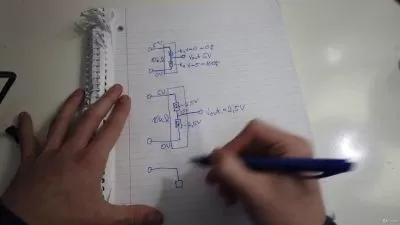Learn Arduino UNO coding using Arduino IDE.
2:28:30
Description
Arduino UNO from scratch.
What You'll Learn?
- Introduction to Arduino.
- Using Arduino to interface various sensors/modules.
- Using arduino to run C++ coding which includes loops, GPIO inputs, UART etc.
- Using Arduino UNO's ADC modules, UART ports and GPIO pins to make various projects.
Who is this for?
What You Need to Know?
More details
DescriptionThis course will allow you to get your hands on one of the most leading microcontroller in the market called Arduino UNO.
This course will introduce you to the Arduino UNO and then it will teach you how you can use this to interface various sensors and modules with Arduino UNO, by using its built-in ports.
Ports of Arduino UNO we will touch in this course are:
1- Analog to digital conversion (ADC) module port.
2- General purpose input and output (GPIO) module port.
3- Univeral Asynchronous Receiver and Transmitter (UART) port.
4- Pulse width modulation (PWM) port.
This course will allow you to learn how to make a counter using a do-while loop, how to interface a button, how to interface an LDR, how to interface an IR receiver LED, how to use PWM port to control brightness of LEDs and many more.
Lecture list is below:
Introduction to Arduino UNO.
09:18
Say hello world using an Arduino UNO on Serial Monitor.
03:59
Blinking an LED with an Arduino UNO.
05:01
Arduino UNO interface with a push button.
13:33
What you learnt about pinMode command till now ? ( Assignemnt ).
1 question
Arduino UNO interface with a Potentiometer using ADC pins.
08:45
Arduino UNO interface with an RGB module.
08:05
Arduino interface LDR ( Light Dependent Resistor ) .
07:39
Suggest useful projects we can make using LDR and Arduino UNO. ( Assignemnt ).
1 question
Arduino UNO interface microwave radar module.
08:41
Arduino UNO interface IR LED to detect fire.
13:14
Arduino UNO interace potentiometer to control the brightness of an LED.
10:34
How to use a do-while loop in an Arduino UNO.
06:22
Modify code of lec 11 and make a counter from 0 to 1000. ( Assignemnt ).
1 question
Using Arduino UNO's PWM pin to control the brightness of an LED.
09:41
Arduino UNO interface piezeoresistor to detect knocks.
09:22
Sound detection using an Arduino UNO.
10:05
Use Arduino UNO and piezeoresistor to plot detected vibrations data.
08:26
A extra lecture, A comparison between arduino UNO and PIC16F877A microcontroller
15:41
So take this opportunity seriously and make your career in this field.
Feel free to message me whenever you need help.
Who this course is for:
- Beginners who want to learn arduino.
This course will allow you to get your hands on one of the most leading microcontroller in the market called Arduino UNO.
This course will introduce you to the Arduino UNO and then it will teach you how you can use this to interface various sensors and modules with Arduino UNO, by using its built-in ports.
Ports of Arduino UNO we will touch in this course are:
1- Analog to digital conversion (ADC) module port.
2- General purpose input and output (GPIO) module port.
3- Univeral Asynchronous Receiver and Transmitter (UART) port.
4- Pulse width modulation (PWM) port.
This course will allow you to learn how to make a counter using a do-while loop, how to interface a button, how to interface an LDR, how to interface an IR receiver LED, how to use PWM port to control brightness of LEDs and many more.
Lecture list is below:
Introduction to Arduino UNO.
09:18
Say hello world using an Arduino UNO on Serial Monitor.
03:59
Blinking an LED with an Arduino UNO.
05:01
Arduino UNO interface with a push button.
13:33
What you learnt about pinMode command till now ? ( Assignemnt ).
1 question
Arduino UNO interface with a Potentiometer using ADC pins.
08:45
Arduino UNO interface with an RGB module.
08:05
Arduino interface LDR ( Light Dependent Resistor ) .
07:39
Suggest useful projects we can make using LDR and Arduino UNO. ( Assignemnt ).
1 question
Arduino UNO interface microwave radar module.
08:41
Arduino UNO interface IR LED to detect fire.
13:14
Arduino UNO interace potentiometer to control the brightness of an LED.
10:34
How to use a do-while loop in an Arduino UNO.
06:22
Modify code of lec 11 and make a counter from 0 to 1000. ( Assignemnt ).
1 question
Using Arduino UNO's PWM pin to control the brightness of an LED.
09:41
Arduino UNO interface piezeoresistor to detect knocks.
09:22
Sound detection using an Arduino UNO.
10:05
Use Arduino UNO and piezeoresistor to plot detected vibrations data.
08:26
A extra lecture, A comparison between arduino UNO and PIC16F877A microcontroller
15:41
So take this opportunity seriously and make your career in this field.
Feel free to message me whenever you need help.
Who this course is for:
- Beginners who want to learn arduino.
User Reviews
Rating

Udemy
View courses Udemy- language english
- Training sessions 16
- duration 2:28:30
- Release Date 2024/12/21









